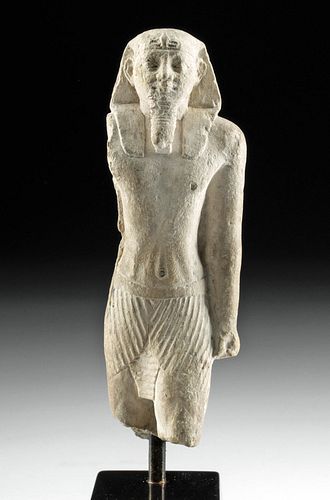Rare Egyptian Limestone Statue Striding Pharaoh
Lot 5
About Seller
Artemis Fine Arts
686 S Taylor Ave, Ste 106
Louisville, CO 80027
United States
Selling antiquities, ancient and ethnographic art online since 1993, Artemis Gallery specializes in Classical Antiquities (Egyptian, Greek, Roman, Near Eastern), Asian, Pre-Columbian, African / Tribal / Oceanographic art. Our extensive inventory includes pottery, stone, metal, wood, glass and textil...Read more
Estimate:
$50,000 - $75,000
Absentee vs Live bid
Two ways to bid:
- Leave a max absentee bid and the platform will bid on your behalf up to your maximum bid during the live auction.
- Bid live during the auction and your bids will be submitted real-time to the auctioneer.
Bid Increments
| Price | Bid Increment |
|---|---|
| $0 | $25 |
| $300 | $50 |
| $1,000 | $100 |
| $2,000 | $250 |
| $5,000 | $500 |
| $10,000 | $1,000 |
| $20,000 | $2,500 |
| $50,000 | $5,000 |
| $100,000 | $10,000 |
| $200,000 | $20,000 |
About Auction
By Artemis Fine Arts
Jun 10, 2021
Set Reminder
2021-06-10 10:00:00
2021-06-10 10:00:00
America/New_York
Bidsquare
Bidsquare : Exceptional Antiquities | Asian | Ethnographic
https://www.bidsquare.com/auctions/artemis-gallery/exceptional-antiquities-asian-ethnographic-7012
Museum-worthy examples of Egyptian, Greek, Roman, Viking, Near Eastern, Far East / Asian, Pre-Columbian, African / Tribal, Oceanic, Native American, Spanish Colonial, Russian, Fossils, Ancient Jewelry, Fine Art, so much more! Artemis Fine Arts info@artemisfinearts.com
Museum-worthy examples of Egyptian, Greek, Roman, Viking, Near Eastern, Far East / Asian, Pre-Columbian, African / Tribal, Oceanic, Native American, Spanish Colonial, Russian, Fossils, Ancient Jewelry, Fine Art, so much more! Artemis Fine Arts info@artemisfinearts.com
- Lot Description
Ancient Egypt, Late Dynastic Period, Saite Period, 26th Dynasty, ca. 664 to 525 BCE. A rare and exemplary statue of a pharaoh, skillfully carved from cream-hued limestone. The figure strides forwards, wearing a pleated skirt, as rigid arms hang from his square shoulders. His bare upper body exhibits a slender waist and strong pectorals, along with an incised navel. Framed by the folds of a nemes headdress topped with a uraeus, his solemn visage is rendered in careful detail with almon-shaped eyes, a bulbous nose, and bowed lips. A vertically striped false beard extends from his chin, its straps travelling up both sides of his face, while plaits of his nemes fall onto his broad shoulders. Light cosmetic lines envelope his ocular regions and radiate from the outer corner of his eyes. Rich with artistic virtuosity, the sculpted detail of this piece is simply stunning! Size: 1.75" L x 1.5" W x 4.25" H (4.4 cm x 3.8 cm x 10.8 cm); 5.625" H (14.3 cm) on included custom stand.
Marking the beginning of the Egyptian Late Dynastic Period, the 26th Dynasty, also known as the Saite period, not only immediately succeeded a dynasty of foreign rule by the Nubian Dynasty, or Kushite Empire, but was also the last native dynasty to rule Egypt before the Persian conquest in 525 BCE. As such, it inhabits a peculiar moment in ancient Egyptian cultural identity, which is clearly evident Saite sculpture.
In their attempt to establish an Egyptian dynasty without being Egyptian themselves, the Kushites had led a revival of sculpture in Egypt and sought inspiration for such from the art from the Middle Kingdom. Thus, when the Saites, a native Egyptian dynasty, took power, they felt the need to stress their Egyptian past and ancestry and instead drew upon art of the Old Kingdom, specifically of the 4th and 5th Dynasties. This meant a greater trend towards naturalism. Taking inspiration from this period of increased artistic virtuosity, Saite sculpture additionally produced a change in the canon of proportions, moving towards a better representation of the cubic structure and detail of a subject. This sculpture clearly exemplifies each of these attributes, displaying exceptional detail in the facial features of the figure and in the textures of the clothing, as well as a realistically proportioned body. Interestingly, this piece is also a unique example of 26th Dynastic art due to his stance. While the standing male figure without attributes, wearing a short kilt, left leg advanced, arms stiff at the sides, and hands clenched in fists is the simplest and oldest of the standing figure types, it is not frequently used throughout the Saite period, making this piece a simultaneously unique and traditional example of 26th Dynastic sculpture.
Limestone occurs in different grades from soft to hard. This figure's remarkably preserved details, such as the face and kilt, are evidence that this piece was carved from stone of the highest grade.
This piece has been searched against the Art Loss Register database and has been cleared. The Art Loss Register maintains the world’s largest database of stolen art, collectibles, and antiques.
Provenance: private New York, USA collection; ex-Mr. Willard collection, USA, prior to 2002
All items legal to buy/sell under U.S. Statute covering cultural patrimony Code 2600, CHAPTER 14, and are guaranteed to be as described or your money back.
A Certificate of Authenticity will accompany all winning bids.
We ship worldwide and handle all shipping in-house for your convenience.
#164982Repair to base with restoration over break lines. Missing proper right arm and lower legs. Chip to beard. Expected abrasions and nicks, especially on proper right side. Light softening of detail. Otherwise, excellent.Condition
- Shipping Info
-
All shipping is handled in-house for your convenience. Your invoice from Artemis Gallery will include shipping calculation instructions. If in doubt, please inquire BEFORE bidding for estimated shipping costs for individual items.
-
- Buyer's Premium



 EUR
EUR CAD
CAD AUD
AUD GBP
GBP MXN
MXN HKD
HKD CNY
CNY MYR
MYR SEK
SEK SGD
SGD CHF
CHF THB
THB














